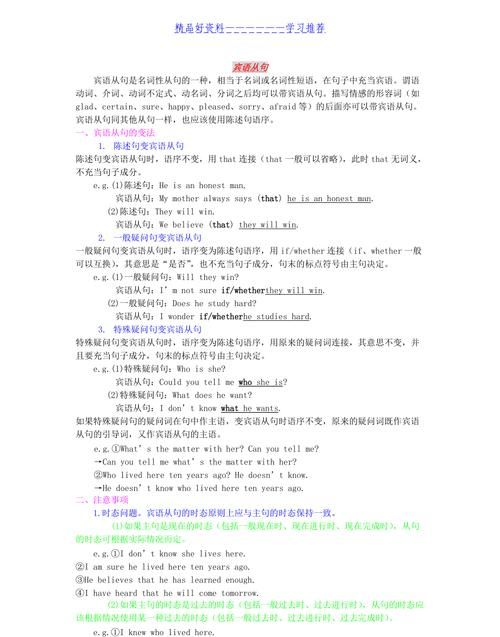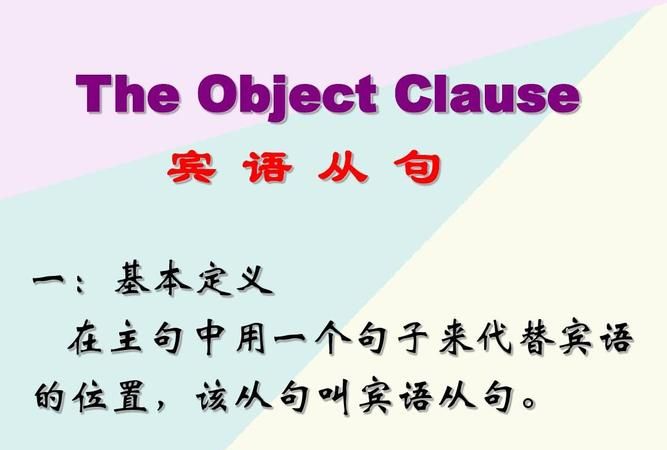本文目录
什么是直接宾语和间接宾语的被动语态
如果一个句子中的某一个动词接了两个宾语,那么,指“人”的是间接宾语,指“物”的为直接宾语。而且,这两个宾语不能形成逻辑上的主谓关系,
如果一个动词后所接的两个宾语能够形成逻辑上的主谓关系,则是宾语和宾补的关系有以下几种情况 1.及物动词+间接宾语+直接宾语
通常及物动词跟双宾语的时候可以转换成to sb.或for sb.,但是有时却不可以。主要是一些相对固定的短语,如:play a trick(on sb.)开某人的玩笑;ask sb.sth.问某人某事;forgive sb.sth.原谅某人某事;cost sb.sth.使某人以某物为代价;kiss sb.goodbye吻别某人;keep sb.company陪某人做伴;call sb.names咒骂某人;mean sb.no harm对某人没有恶意;drop sb.a line给某人写一封便信/留下便条等。
2.及物动词+直接宾语+to+间接宾语
有些动词,如pass,give,leave,throw,lend,sell,offer,tell,pay,write,teach,show,promise,telephone等所跟的双宾语可以转换成由to引导的短语。
She showed me her s tamp collection album.她把她的集邮册拿给我看。
=She showed her stamp collection album to me.
She said she would pay you a visit a week later.她说她一周后要来看你。
=She said she would pay a visit to you a week later.
注意:及物动词explain,say,announce等跟双宾语时,即使指人的间接宾语在直接宾语前面也要用介词to。
3.及物动词+直接宾语+for+间接宾语
有些动词,如make,order(订购),cook,buy,build,fetch,find,cut,save,choose,sing等所跟的双宾语可以转换成由for引导的短语。
She cooked her husband a delicious meal.她给丈夫做了一顿可口的饭菜。
=She cooked a delicious meal for her husband.
I'll buy you some new clothes tomorrow.我明天去给你买一些新衣服。
=I'll buy some new clothes for you tomorrow.
4.主语+间接宾语+宾语从句(直接宾语)
直接宾语是宾语从句时,宾语从句可以用that,when,whether,if,how等引导,此时的间接宾语不可以置于直接宾语之后,因为会引起句子的“头重脚轻”。
百度也许可以找到你想要的,有时语法不必深究,时间长了有语感,自然而然就会了

英语直接宾语和间接宾语
【注意】直接引语中的时间状语根据实际情况转述为间接引语时,有时不需要改变。
直接引语在改为间接引语时、时态需要做相应的调整。
现在时它需改为过去时态;过去时态改为完成时;过去完成时则保留原来的时态。如:
1)She said. "I have lost a pen."→She said she had lost a pen
2)She said. "We hope so."→She said they hoped so.
3) She said. "He will go to see his friend。"→She said he would go to see his friend。
但要注意在以下几种情况下。在直接引语变为间接引语时,时态一般不变化。
①直接引语是客观真理。
"The earth moves around the sun and the moon moves around the earth, the teacher told me. → The teacher told me the earth moves around the sun and the moon moves around the earth。
②直接引语是过去进行时,时态不变。如:
Jack said. "John, where were you going when I met you in the street?"→Jack asked John where he was going when he met him in the street。
③直接引语中有具体的过去某年、某月、某日作状语,变为间接引语时,时态不变。如:
Xiao Wang said. "I was born on April 2l, 1980。" →Xiao Wang said he was born on April 20, 1980。
④直接引语如果是一般现在时。表示一种反复出现或习惯性的动作,变间接引语,时态不变。如:
He said, "I get up at six every morning。" →He said he gets up at six every morning。
⑤如果直接引语中的情态动词没有过去时的形式(例:ought to, had better, used to)和已经是过去时的形式时,(例:could, should, would, might)不再变。如:
Peter said. "You had better come have today。" →Peter said I had better go there that day。
如何变状语:
直接引语变间接引语,状语变化有其内在规津,时间状语由“现在”改为“原来”(例:now变为then, yesterday。变为 the day before)地点状语,尤其表示方向性的,或用指示代词修饰的状语,由“此”改为“彼”(例:this 改为that),如:
He said, "These books are mine." →He said those books were his
4.5含有双宾语的动词在变为被动语态时,有以下三种情形:
一、有些双宾动词(如award, buy, give, leave, lend, offer, pay, show, teach, tell等)在变为被动语态时,既可把间接宾语(指人)变为被动语态的主语,而把直接宾语(指事物)保留下来(称为保留宾语),也可把直接宾语(指事物)变为被动语态的主语,而把间接宾语改为介词to 或for引起的状语(到底用to还是for,与所搭配的动词有关)。比较:
He gave her some money. 他给她一些钱。
→ She was given some money.
→Some money was given to him.
He bought her a watch. 他给她买了一快表。
→ A watch was bought for her.
→She was bought a watch.
二、有些双宾动词(如bring, do, make, pass, sell, send, sing, write等)通常用直接宾语(指事物)作被动语态的主语,而将间接宾语用作保留宾语(其前根据情况用介词to或for):
Father made me a doll.
→ A doll was made for me.
He wrote her a letter.
→ A letter was written to her.
三、有些双宾动词(如answer, deny, envy, refuse, save, spare等)通常用间接宾语(指人)作被动语态的主语,而将直接宾语用作保留宾语:
He answered me that question.
→ I was answered that question by him.
直接引语间接引语的区别
直接引语:直接引述别人的话(句子中有“”)。
间接引语:用自己的话转述别人的话,叫“间接引语”(句子中一般无“”)
二.直接引语变间接引语
A.一般不表示请求或祈使的句子改为一个宾语从句
1.连词
若直接引语引号里的内容是陈述句,那么改为间接时,要用连词 that (可以省略)
……………….一般疑问句,…….,要用连词 if/whether (不可以省略)
……………….特殊疑问句,…….,要用连词 wh- 即特殊疑问词本身(不可省)
2.变化
(1)主句动词的变化
一般说来,主句谓语动词常为said或said to,变为间接引语时,当直接引语是陈述句时,said不变。当直接引语是一般疑问句和特殊疑问句时,则要把said或said to变为asked / asked sb.
(2)从句人称的变化
由直接引语变间接引语时,从句的主语人称要遵循一主、二宾、三不变的原则。①直接引语的主语是第一人称变为间接引语时要和主句的主语保持一致。②如果直接引语的主语是第二人称变为间接引语时要与主句的宾语保持一致。③如果直接引语的主语是第三人称变为间接引语时,人称不变。例如:
①They said, “We will go there by bus.” →They said they would go there by bus.
②She said to me, “Are you interested in science?” →She asked me if I was interested in science.
③His mother said to me, “He can't go to school.” →His mother told me that he couldn't go to school.
(3)、从句动词时态的变化
a. 如果主句的时态是一般过去时,从句的时态则应是与主句时态相应的过去时态。①一般现在时→一般过去时;②一般过去时→过去完成时;③现在进行时→过去进行时;④现在完成时→过去完成时;⑤过去完成时→过去完成时(不变);⑥一般将来时→过去将来时。例如:
The girl said, “I'm sorry for being late for class.” →The girl said that she was sorry for being late for class.
b. 直接引语变为间接引语时,如果主句中的谓语动词是一般现在时或一般将来时,则间接引语从句的时态保持不变。例如:
He says, “I have finished my homework.” →He says that he has finished his homework.
She will say, “I'll do it tomorrow.” →She will say that she'll do it the next day.
c. 直接引语如果是客观事实或真理,变为间接引语时,从句时态不变。例如:
The teacher said, “The earth moves around the sun.” →The teacher said that the earth moves around the sun.
(4)、指示代词、时间状语、地点状语和动词的变化
直接引语变为间接引语时,指示代词的变化为this→that, these→those等;时间状语的变化为now→then, today→that day, yesterday→the day before, tomorrow→the next day等;地点状语的变化为here→there;动词的变化为come→go(go 不要变come)。例如:
1. She said, “I will come this evening.” →She said that she would go that evening.
2. He said, “My sister was here three days ago, but she is not here now.” →He said that his sister had been there three days before, but she was not there then.
B.表示请求或祈使的句子改为句型tell/ask/order sb (not) to do sth
当直接引语引号里的内容表示要求时用tell sb (not) to do sth
当直接引语引号里的内容表示请求时用ask sb (not) to do sth
当直接引语引号里的内容表示强制要求时用order sb (not) to do sth

直接宾语和间接宾语和宾语补足语的区别
直接宾语、间接宾语和宾语补足语都是句子成分。
一、直接宾语和间接宾语。
英语中有些动词需要两个同等的宾语,即直接宾语(direct object)与间接宾语(indirect object)。直接宾语一般指动作的承受者,间接宾语指动作所向的或所为的人或物(多指人)。具有这种双宾语的及物动词叫做与格动词(dative verb),常用的有answer,bring,buy,deny,do,fetch,find,get,give,hand,keep,leave,lend,make,offer,owe,pass,pay,play,promise,read,refuse,save,sell,send,show,sing,take,teach,tell,throw,wish,write等。间接宾语一般须与直接宾语连用,通常放在直接宾语之前。如:
He never made me such excuses. 他从未向我表示过这种歉意。
I have found him a place. 我给他找到了一个职位。
She made her son a scarf. 她为她的儿子做了一条领巾。
由于种种原因,间接宾语亦可置于直接宾语之后,但其前一般须用介词to或for。如:
I gave my address to him. 我把我的地址给了他。(强调间接宾语him)
He threw the ball to me, not to Tom. 他将球扔给了我,没有扔给汤姆。(强调me和Tom,并使二者形成对照)
I have found a place for Bob, who is my brother. 我给鲍勃找到了一个职位,他是我的兄弟。(间接宾语Bob后有修饰语)
如直接宾语都是代词,间接宾语亦应放在直接宾语之后。如:
Give it to me. 把它给我。
Why didn’t you show it to him? 你为什么没有将它给他看?
如果直接宾语是一从句,间接宾语亦必须放在直接宾语之前。如:
I wrote him that he should come at once. 我写信叫他马上来。
二、宾语补语。
补足宾语的意义的句子成分叫做宾语补语(object complement)。
宾语补语一般皆置于宾语之后。如:
John wears his hair very long. 约翰留着很长的头发。
She has her hands black. 她把手弄黑了。(如说black hands,则意谓她手的肤色是黑的)
可以用作宾语补语的有名词、形容词、不定式、动名词、分词、介词短语等。如:
They named the child Jimmy. 他们将孩子命名为吉米。
My mother looks so young that you would think her my sister. 我的母亲面很嫩,你会以为她是我的姐姐。
She boiled the egg hard. 她将鸡蛋煮老了。
I found the book very interesting. 我发现这本书很有趣。
The comrades wanted Dr. Bethune to take cover. 同志们要白求恩大夫隐蔽了一下。
Tom is ill. Let’s go and see him. 汤姆病了,我们去看看吧。
I call this robbing Peter to pay Paul. 我把这个叫做拆东干墙补西墙。
I have guests coming. 我有客人要来。
Can I have this parcel weighed here? 我可以在这儿称一下这个包裹吗?
I found everything in good condition. 我发现一切情况都很好。

什么是直接宾语什么是间接宾语
一般情况下,直接宾语指物,间接宾语指人。
双宾语由直接宾语和间接宾语组成。直接宾语是谓语动词的承受者,间接宾语表示谓语动作的方向(对谁做)或动作的目标(为谁做),它和直接宾语组成双宾语。

以上就是关于带直接宾语和间接宾语的从句 ,什么是直接宾语和间接宾语的被动语态的全部内容,以及带直接宾语和间接宾语的从句 的相关内容,希望能够帮到您。
